foundry vat

stainless steel chocolate processing vat
industrial parts bin
Deborah Silver is an accomplished and experienced landscape and garden designer whose firm first opened its doors in 1986.
foundry vat

stainless steel chocolate processing vat
industrial parts bin
My collection of wood fragments, stones, mosses and bugs pale in visual comparison to my shells. They are objet trouve of a special sort. I am not a shell scholar; I am a shell finder. My first trip to Lake Michigan, my first trip to Atlantic ocean, a visit to Cape Hatteras-I have some shells that I collected. I have 8 of these particular shells-they found me. Meaning, I wrote a check. I had to look up the name-Cypraea aurantium. I do not know what waters call it a native, but there is certainly nothing like it in the Great Lakes. I know nothing of its habit, or habitat. But I do know they are incredibly beautiful objects. This photograph does not begin to do the shape, the surface, the color, or the texture any justice. It might be the most fabulous outfit for a living organism that I have ever seen. I have had them in a bowl in my drafting studio for years. To hold them in my hand, turn them over, and imagine the life they once protected-an experience of the miracle that is nature.
I have a big love for the miracle that is nature. I have a room-a repurposed back porch- devoted to my objet trouve. My beaver skulls-to look at those teeth, I have no problem imagining them felling trees for their dams. Bugs, butterflies and rocks. Old letters. Sculptures, prints and plates of birds, fish, and flowers. I call this room the reliquary-a place for various relics. A friend gave me her Mom’s collection of Susan B Anthony dollars-a sign of the importance of our friendship. Painted plaster saints. Quirky sculptures made in grade school, a hydrangea ball from Espace Buffon in Paris. It is a collection of objects of interest, beauty, or meaning. Souvenirs, if you will.

The shell grottoes in Italy and England-how I envy those gardeners their shelled fountains and follies. Would I ever get there to see them in person? My climate would not permit any such expression of my own outdoors. This room was looking like a home for the shells, but it was already stuffed with this and that. I went up. I had Don Taylor take the ceiling out, and build me a six foot square tower some 14 feet off the floor-in exterior grade plywood. Each side of the tower had a half round window-I wanted the tower to be flooded with light. My shell collection was no doubt inadequate for the job. I went shopping.
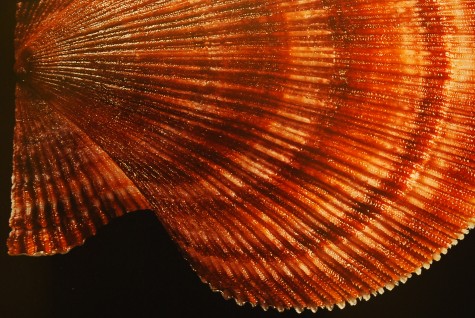
How does one design a shelled tower? I didn’t. I decided arbitrarily that all of the shells would be peach, orange, and white-and any combination thereof. I bought lots of everything, as I had no idea how I would proceed once I was face to face with the project. I loved this approach. I cannot treat a landscape project like this. I was completely at ease that it would just evolve. My shopping for shells taught me much about rarity. Rare shells, like my cypraea, are priced by the shell. Abundant shells are priced by the hundreds, or in the case of small shells, by the gallon. This Irish Flat pictured above-the bounty of the sea. They are large, and inexpensive. I bought lots.
 The ceiling scared me. I rented scaffolding; I needed an 8 foot ladder just to get to the scaffolding surface. The thought of climbing another tall ladder based on the scaffolding, and gluing shells in a pattern up over head-whoa. Who knows where I got the idea to glass the ceiling. But one material and one material only up there seemed like a good idea. Beach glass-that adjunct to shelling-perfect. Perfect, but not that easy. Where does one get lots of tumbled recycled bottle glass? I did not have enough time left in my life to collect it. I found it; an objet trouve available in quantity. 25 pound boxes, sent from California. The cost of the glass-next to nothing. The shipping-astonishing. I was even more scared now-which felt good. I spent the better part of a half day all winter long, the music blasting, on a ladder. 750 pounds of beach glass went on that ceiling to start. I glued multiple layers of glass. I wanted the tower to look rounded-not flat-sided. I had help with the adhesive part. Ceramic tile mastic-I liberally buttered each piece of glass with it, and pressed up. It took no time to stick, but a week to cure. I would glue as much as I could stand to before my fear of the height would overtake me. Not one piece of glass has ever come loose.
The ceiling scared me. I rented scaffolding; I needed an 8 foot ladder just to get to the scaffolding surface. The thought of climbing another tall ladder based on the scaffolding, and gluing shells in a pattern up over head-whoa. Who knows where I got the idea to glass the ceiling. But one material and one material only up there seemed like a good idea. Beach glass-that adjunct to shelling-perfect. Perfect, but not that easy. Where does one get lots of tumbled recycled bottle glass? I did not have enough time left in my life to collect it. I found it; an objet trouve available in quantity. 25 pound boxes, sent from California. The cost of the glass-next to nothing. The shipping-astonishing. I was even more scared now-which felt good. I spent the better part of a half day all winter long, the music blasting, on a ladder. 750 pounds of beach glass went on that ceiling to start. I glued multiple layers of glass. I wanted the tower to look rounded-not flat-sided. I had help with the adhesive part. Ceramic tile mastic-I liberally buttered each piece of glass with it, and pressed up. It took no time to stick, but a week to cure. I would glue as much as I could stand to before my fear of the height would overtake me. Not one piece of glass has ever come loose.
 I planned ahead a little bit-electricity which would power a light fixture was in place before I started with the ceiling. Once the glass was on the ceiling-now what? I took my cue from the shape of the windows. I cannot explain the design any other way. I made one move, on all fours sides, and regrouped. These pictures do not show the put up and rip down days. It was my winter; I had time to make mistakes or changes, and start over.
I planned ahead a little bit-electricity which would power a light fixture was in place before I started with the ceiling. Once the glass was on the ceiling-now what? I took my cue from the shape of the windows. I cannot explain the design any other way. I made one move, on all fours sides, and regrouped. These pictures do not show the put up and rip down days. It was my winter; I had time to make mistakes or changes, and start over.
 Out the tower window to the west-my chimney. Around the window, I glued an embarrassment of riches in egg cowries. Then I shelled the wood molding that came with the window. Then a window molding fashioned of a double row of Irish flats. Each shell I sorted by size. No one would notice a gap from the floor, but I was on the scaffolding ladder, face to face with the chimney. The design had everything to do with the view from the floor-I am sure I went up and down that pair of ladders plenty. The tower itself was built amazingly true and square, but shells of a given species vary considerably in shape and size. A lot of tinkering went on.
Out the tower window to the west-my chimney. Around the window, I glued an embarrassment of riches in egg cowries. Then I shelled the wood molding that came with the window. Then a window molding fashioned of a double row of Irish flats. Each shell I sorted by size. No one would notice a gap from the floor, but I was on the scaffolding ladder, face to face with the chimney. The design had everything to do with the view from the floor-I am sure I went up and down that pair of ladders plenty. The tower itself was built amazingly true and square, but shells of a given species vary considerably in shape and size. A lot of tinkering went on.
 None of the shells I used were rare. The smallest of the shells-the white calpurnus that I glued up by the hundreds-are barely an inch long. Each and every one of the other species of shells has a distinctive shape, pattern, and color I like. Better yet, I have my own folly.
None of the shells I used were rare. The smallest of the shells-the white calpurnus that I glued up by the hundreds-are barely an inch long. Each and every one of the other species of shells has a distinctive shape, pattern, and color I like. Better yet, I have my own folly.
 This project took a little over 2 months of my winter. The good part- I cannot remember one thing about the weather, the snow, the cold or the gray that year.
This project took a little over 2 months of my winter. The good part- I cannot remember one thing about the weather, the snow, the cold or the gray that year.
Correct me if I am wrong Delphine, but I believe the French phrase “objet trouve” translates literally as found art. Any ordinary object, prized in some way for its aesthetic qualities, qualifies. as art, that is. I have questions. Are there are rules about what constitutes art? I am instantly over my head here. Question 2-if there is art that is found, who does the finding? Is part of the art in the finding? These questions I can warm up to. I go to a museum, expecting to find art. A museum provides a home for art treasured by the greater community, yes? Generations of museum directors, curators, artists, art historians and museum boards presumably recognize art and fund acquisitions. In this instance, I am a viewer, not a finder. I will admit I see some works in museums or galleries that I would not identify as art, except for their address. This might be ignorance, or it might be that the eye of the beholder counts for something. This particular bracket fungus has been with me at least 30 years. It means something to my eye. The shape, the mass, the line, the color-everything about it engages me. It is beautiful. It is also the fruiting body of a deadly fungus. I am a gardener-I think about life, death, and second chances every day. This bracket fungus is by no means a Degas sculpture; it is an objet trouve. I am the finder.

I do collect bugs. Big bugs from Indonesia, Malaysia, wherever-suffice it to say any jewel of a bug will catch my eye. My bugs-I buy them mounted and framed. Someone else was a finder. This bug-its size is astonishing. Not the kind of thing I would want to run across in my garden or closet, but behind glass, I can appreciate it. The substantial body sustains four wings, and a pair of really long legs. The artist of record here-nature. There are those of us who would frame mounts of what objet trouve nature has to offer; I am one of those.
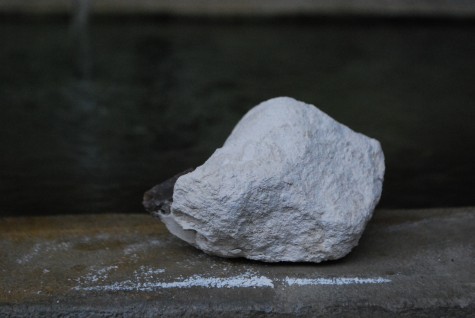 This rock, take my word for it-an objet trouve. This is not just any ordinary white rock; the history is as follows. This is a chalk rock, from the white cliffs of Dover. Dover, England. So many years ago, on an early shopping trip for Detroit Garden Works, Rob found himself on those cliffs. He pocketed this rock for me, and brought it home. An English chalk rock with a flint toe that he collected on my behalf-an objet trouve. It is an object from a place I have never been. It smells like the ocean. It was meant for me; I had a part in this trip, but not a presence. I will admit I chalked the concrete surface it sits on before I photographed it.
This rock, take my word for it-an objet trouve. This is not just any ordinary white rock; the history is as follows. This is a chalk rock, from the white cliffs of Dover. Dover, England. So many years ago, on an early shopping trip for Detroit Garden Works, Rob found himself on those cliffs. He pocketed this rock for me, and brought it home. An English chalk rock with a flint toe that he collected on my behalf-an objet trouve. It is an object from a place I have never been. It smells like the ocean. It was meant for me; I had a part in this trip, but not a presence. I will admit I chalked the concrete surface it sits on before I photographed it.

The minerals of the world are can be very flashy and exotic looking, once they are cut and or polished. Someone had the idea to treat this rock as something very special. It has been cut in a spherical shape, and the interior surfaces are exposed and polished. It is gallery ready-the gallery at my house, that is.
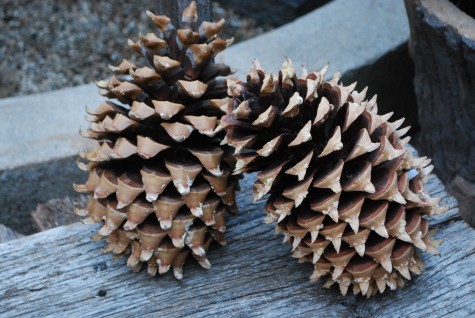 The coulter pine produces some of the largest pinecones in the world. This pair of cones are 12 inches tall, and weigh 3 pounds each. The woody scales are enormous, and impenetrable to a a knife or a screwdriver. The seeds of this pine are indeed well protected. The ends of the scales are sharp, and coated in congealed pine pitch. They are hefty and very handsome objects.�
The coulter pine produces some of the largest pinecones in the world. This pair of cones are 12 inches tall, and weigh 3 pounds each. The woody scales are enormous, and impenetrable to a a knife or a screwdriver. The seeds of this pine are indeed well protected. The ends of the scales are sharp, and coated in congealed pine pitch. They are hefty and very handsome objects.�
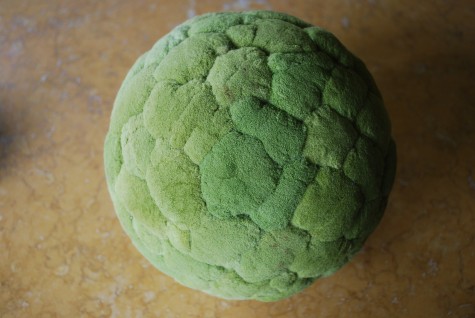 Cattails can be found in any and every marshy place near me. I have collected them plenty of times for a fall arrangement. Someone had the idea to cut them in sections, affix them to a sphere shape, and dye them; they did the finding. Once they determined that a cattail was an object of aesthetic interest, they transformed it in such a way that this particular idea of beautiful is clear to me.
Cattails can be found in any and every marshy place near me. I have collected them plenty of times for a fall arrangement. Someone had the idea to cut them in sections, affix them to a sphere shape, and dye them; they did the finding. Once they determined that a cattail was an object of aesthetic interest, they transformed it in such a way that this particular idea of beautiful is clear to me.
 This very old Italian wood fragment was the beginning of a sculpture which includes a stone base, shells,and a finial of fossil coral. When I first saw it, I thought the wood fragment had gone down with a ship, and been preserved in some primordial mud. Not so. The objet trouve is the introductory and organizing shape for the sculpture that came later.
This very old Italian wood fragment was the beginning of a sculpture which includes a stone base, shells,and a finial of fossil coral. When I first saw it, I thought the wood fragment had gone down with a ship, and been preserved in some primordial mud. Not so. The objet trouve is the introductory and organizing shape for the sculpture that came later.
 Jenny made me this sculpture for Christmas. Clearly, it is a pair of pants. This forked limb had some quality that attracted and interested her. The resulting sculpture makes that clear. I like it for what it was; I like much better what it has become, given her sculpting.
Jenny made me this sculpture for Christmas. Clearly, it is a pair of pants. This forked limb had some quality that attracted and interested her. The resulting sculpture makes that clear. I like it for what it was; I like much better what it has become, given her sculpting.
 These white porcelain objects are lights from an English dairy farm. I have no idea why they have this shape. I am sure it was not a matter of what the cows or the farmer would find pleasing. It is the special visual gift of utilitarian objects that they are designed simply to function properly and efficiently. Buck arranged 9 of these lights in a grid. A light fixture from found objects.
These white porcelain objects are lights from an English dairy farm. I have no idea why they have this shape. I am sure it was not a matter of what the cows or the farmer would find pleasing. It is the special visual gift of utilitarian objects that they are designed simply to function properly and efficiently. Buck arranged 9 of these lights in a grid. A light fixture from found objects.

Found objects have their place in a landscape, or a garden. A landscape and a garden can provide no end of objet trouve. I so like a street that goes both ways.
 Faiencerie Figueres & Fils is a shop in Marseilles France well known to us. Rob has been buying their glazed ceramic creations for a good many years. It is a but one of countless small creative businesses that exist all over the planet. It is a very small family owned business. They work very hard, producing objects of great beauty. We happen to love their plates and bowls of fruits and vegetables. They create sculpture from a love and appreciation from the bounty of nature.
Faiencerie Figueres & Fils is a shop in Marseilles France well known to us. Rob has been buying their glazed ceramic creations for a good many years. It is a but one of countless small creative businesses that exist all over the planet. It is a very small family owned business. They work very hard, producing objects of great beauty. We happen to love their plates and bowls of fruits and vegetables. They create sculpture from a love and appreciation from the bounty of nature.
 Their enterprise began in the 1950’s-the brainchild and passion of the Figueres family. I will admit to a fondness for this particular vintage. Beyond the family business, Gilberte Figueres has herself spent a lifetime creating and painting china in the tradition of the Vieux Marseilles faience. She and her husband, and their children, to whom they refer with great affection, as the rookies, have made a life from their art. The first time Rob shopped with them, they insisted on a proper introduction. To the family, and only then, to the business.
Their enterprise began in the 1950’s-the brainchild and passion of the Figueres family. I will admit to a fondness for this particular vintage. Beyond the family business, Gilberte Figueres has herself spent a lifetime creating and painting china in the tradition of the Vieux Marseilles faience. She and her husband, and their children, to whom they refer with great affection, as the rookies, have made a life from their art. The first time Rob shopped with them, they insisted on a proper introduction. To the family, and only then, to the business.
 The fruits and the vegetables of Provence inspire their work. I remember from so many years ago Rob explaining that each piece is cast, and bisque fired. The glazes are clear when applied. So how would they know the application of a glaze or group of glazes that would transform a bisque fig perfectly into a convincingly colored fig? I have no real need to know; I love the magical quality of their work.
The fruits and the vegetables of Provence inspire their work. I remember from so many years ago Rob explaining that each piece is cast, and bisque fired. The glazes are clear when applied. So how would they know the application of a glaze or group of glazes that would transform a bisque fig perfectly into a convincingly colored fig? I have no real need to know; I love the magical quality of their work.
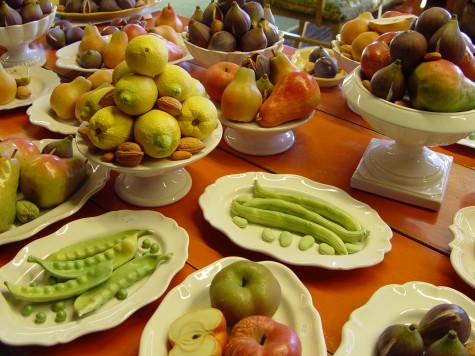 There are the plates. Usually white. There may be peas applied to that plate, or mushrooms, or apples-some whole, some cut. The plates can be hung on a wall. The footed dishes are piled high with fruits, nuts, figs, pears, apples, lemons. The day all of these sculptures arrived and got unpacked-a good day. From balls of clay they fashion the individual figs-some whole, some ripe and split open.
There are the plates. Usually white. There may be peas applied to that plate, or mushrooms, or apples-some whole, some cut. The plates can be hung on a wall. The footed dishes are piled high with fruits, nuts, figs, pears, apples, lemons. The day all of these sculptures arrived and got unpacked-a good day. From balls of clay they fashion the individual figs-some whole, some ripe and split open.
 I made a home for these extraordinarily beautiful sculptures-why wouldn’t I? They come from a place very unlike where I live. There is a very different life, a very different aesthetic at work. No matter what seems strange; I have no problem letting go of that. There is a common thread. A local person with passion and direction -I recognize what looks like passion from a long ways away, just as easily as I recognize it next door.
I made a home for these extraordinarily beautiful sculptures-why wouldn’t I? They come from a place very unlike where I live. There is a very different life, a very different aesthetic at work. No matter what seems strange; I have no problem letting go of that. There is a common thread. A local person with passion and direction -I recognize what looks like passion from a long ways away, just as easily as I recognize it next door.
 This arrangement of pears is a pretty quiet affair. Should I take or have the time to focus on it, I am taken with the spots, the lumps, the bruises, and the splits. Anyone who gardens recognizes the blush of the summer sun, the spots characteristic of a given variety, the ripe fruit splitting, the bruises or blemishes from bugs or hail-all those signs of life.
This arrangement of pears is a pretty quiet affair. Should I take or have the time to focus on it, I am taken with the spots, the lumps, the bruises, and the splits. Anyone who gardens recognizes the blush of the summer sun, the spots characteristic of a given variety, the ripe fruit splitting, the bruises or blemishes from bugs or hail-all those signs of life.
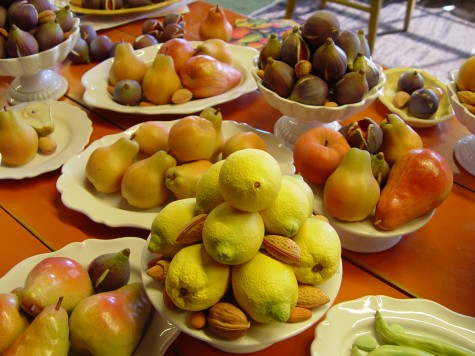 The signs of life-they are many. I could read every day about the production of fruit, and in the end, not know much more about it than what I see here.
The signs of life-they are many. I could read every day about the production of fruit, and in the end, not know much more about it than what I see here.
 I have very few of these beautiful sculptures left. I am not surprised. They appeal to me in the same way as hand made Italian terra cotta, or handmade shutters or window boxes. Once these sculptures are gone, I will be longing to have them again. Never anywhere else have I seen anything quite like them. This is a wordy way of saying genuinely felt and hand made objects catch my eye. The evidence of the human hand interests me.
I have very few of these beautiful sculptures left. I am not surprised. They appeal to me in the same way as hand made Italian terra cotta, or handmade shutters or window boxes. Once these sculptures are gone, I will be longing to have them again. Never anywhere else have I seen anything quite like them. This is a wordy way of saying genuinely felt and hand made objects catch my eye. The evidence of the human hand interests me.

The big idea here? Handmade counts for so much. Your handmade-as in the Christmas jam, the holiday letters, the package wrap, the Sunday dinners, the vegetable patch, the paintings and sculptures, the landscape and garden design-I am likely to pay close attention. Handmade is the real work of a particular pair of hands. I like whenever possible to recognize and support talented people. Handmade-you are looking at it. Read for yourself. www.faiencerie-figuere.com. Let me know what you think.
Deborah Silver is a landscape and garden designer whose firm, Deborah Silver and Co Inc, opened its doors in 1986. She opened Detroit Garden Works, a retail store devoted to fine and unusual garden ornament and specialty plants, in 1996. In 2004, she opened the Branch studio, a subsidiary of the landscape company which designs and manufactures garden ornament in a variety of media. Though her formal education is in English literature and biology, she worked as a fine artist in watercolor and pastel from 1972-1983. A job in a nursery, to help support herself as an artist in the early 80’s evolved into a career in landscape and garden design. Her landscape design and installation projects combine a thorough knowledge of horticulture with an artist’s eye for design. Her three companies provide a wide range of products and services to the serious gardener. She has been writing this journal style blog since April of 2009.
Copyright © 2024 · Deborah Silver & Co. · Detroit Garden Works